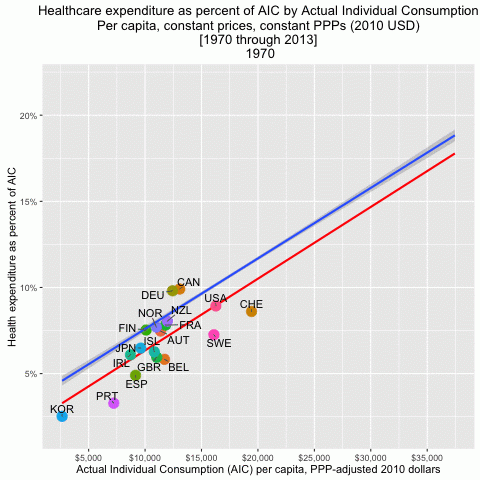- | Healthcare Healthcare
- | Expert Commentary Expert Commentary
- |
Spending a Lot on Healthcare Is the American Way
We're a nation of consumers: Big houses, the latest gadgets, huge hospital bills.
The U.S. has some of the most expensive medicine in the world, with health-care spending now almost 18 percent of gross domestic product. But why? And might we hope to get this spending down? Unfortunately, expensive health care is embedded in the American way of life -- more specifically, the American desire to live it up with high consumption.
As outlined by the blog Random Critical Analysis, U.S. health-care expenditures go well beyond what the U.S.’s relatively high per capita GDP might lead us to expect. But viewed through the lens of consumption behavior, American health-care spending is typical of this nation’s habits and mores. Relative to GDP, Americans consume a lot more than Europeans, and our health-care spending is another example of that tendency.
Why is American consumption so disproportionate to American GDP? One reason is the relatively low household savings rate, or possibly American net wealth is high relative to GDP.
Consumption in the U.S., per capita, measures about 50 percent higher than in the European Union. American individuals command more resources than people in countries such as Norway or Luxembourg, which have higher per capita GDP. The same American consumption advantage is evident if you look at dwelling space per person or the number of appliances in a typical home.
Once we focus on consumption, America’s high health-care expenditures no longer appear so unusual. In fact, if you graph health-care expenditures, per capita, against individual consumption, the fit is very close across developed nations. In other words, the spending bug tracks into health care, too. 
To put it most simply, we Americans spend a lot on health care because we spend a lot period.
Is health care best thought of as a kind of consumption decision? That’s debatable, because spending on better health is also an investment in longevity, comfort and lifetime earnings. It’s not like buying a new dress or a fancy ski vacation. Yet Americans nonetheless seem to mentally treat a lot of health care as similar to personal consumption. They may want a particular doctor, or a sufficiently comfortable hospital, the latest technology or the very best prescription drug to make them feel better as quickly as possible. As a nation, we are relatively intolerant of long waits, and we’re not sufficiently focused on the long-term solutions of exercise and good diet. We love the quick fix, we want it on our terms, and we hate being told no. We’re willing to go to extreme lengths to keep medical patients alive, rather than giving up hope, even when less intervention might be the more rational medical decision.
I do think these tendencies reflect a kind of American national weakness, and that we would be better off if we had a less consumerist, more philosophical, and indeed more spartan approach to our health and well-being. That would lead to less overtreatment, less strain on health-care resources, and in the longer run a healthier nation with a sounder fiscal position for the federal government.
But I just don’t see this nation on the verge of such a change, and so the message here is somewhat pessimistic. Americans love their personal consumption, and household savings rates have been mostly falling since the early 1980s. Those are long-term cultural trends that no health-care policy will reverse. We should be grateful for whatever cost control we can get, because it is running counter to some fairly fundamental principles of the American economy and what the American people expect out of life.
Furthermore, we shouldn’t take the lower health-care spending in many European nations as a sign of better health-care policy. It’s a reflection of a broader cultural difference. If the U.S. someday did move to a single payer system for health care, it probably would be a relatively expensive version of that idea. The U.S., of course, does have a partial single payer system through Medicare, and it is still more expensive per beneficiary than its European equivalents.
When it comes to understanding America, including its health care, the spending bug is more important than you might think.